El Alto
El Alto (Spanish for "The Heights"[1]) is the second-largest city in Bolivia, located adjacent to La Paz in Pedro Domingo Murillo Province on the Altiplano highlands. El Alto is today one of Bolivia's fastest-growing urban centers, with an estimated population of 943,558 in 2020.[2] It is also the highest major city in the world, with an average elevation of 4,000 m (13,123 ft).[3]
El Alto
Patamarka | |
|---|---|
City and municipality of El Alto | |
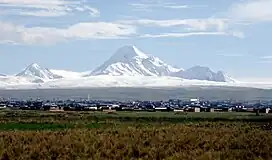 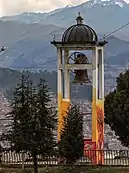 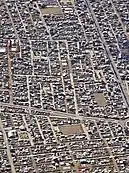 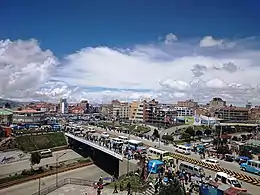 El Alto City | |
 Flag  Coat of arms | |
| Motto: Desde la cumbre más alta del mundo levantase la ciudad donde jamás se pondrá el sol de nuestra raza (From the highest summit in the world rises the city where the sun of our race will never set) | |
 El Alto Location within Bolivia 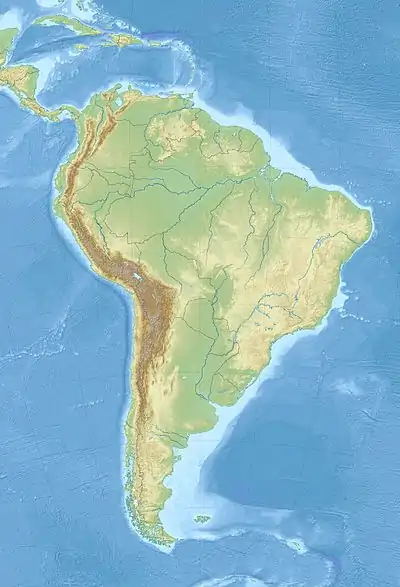 El Alto El Alto (South America) | |
| Coordinates: 16°30′17″S 68°09′48″W | |
| Country | |
| Department | |
| Province | Pedro Domingo Murillo |
| Municipality | El Alto Municipality |
| Government | |
| • Mayor | Eva Copa |
| Area | |
| • City and municipality of El Alto | 363 km2 (140 sq mi) |
| Elevation | 4,150 m (13,620 ft) |
| Population (2020 Census) | |
| • Rank | 2nd |
| • Urban | 943,000 |
| • Metro | 2,200,000 |
| Time zone | UTC−4 (BOT) |
| Website | Official website |
The El Alto–La Paz metropolitan area, formed by La Paz, El Alto, Achocalla, Viacha, and Mecapaca, constitutes the most populous urban area of Bolivia, with a population of about 2.2 million.
History
The dry and inclement plain above La Paz was uninhabited until 1903 when the newly built railways from Lake Titicaca and Arica reached the rim of the canyon, where the La Paz terminus, railyards and depots were built along with a settlement of railway workers (a spur line down into the canyon opened in 1905). In 1925, the airfield was built as a base for the new air force, which attracted additional settlement. In 1939, El Alto's first elementary school opened. El Alto started to grow tremendously in the 1950s when the settlement was connected to La Paz's water supply (before this, all water had to be transported from La Paz in tanker vehicles) and building land in the canyon became more and more scarce and expensive. In an administrative reform in March 1985, the district of El Alto and its surroundings were politically separated from the City of La Paz (this date is officially referred to and celebrated as the city's "founding day"). In 1987, El Alto was formally incorporated as a city. In 1994, the city became the seat of the Roman Catholic Diocese of El Alto.
Districts
El Alto's autonomous government identifies 14 districts composing the city.
Demographics
El Alto is the largest city in Latin America with a mostly Indigenous population. About 76% of its inhabitants are Aymara, 9% are Quechua, 15% are Mestizo (descendants of Indigenous and Europeans), and less than 0.1% are Criollos (White). El Alto was once known as La Paz's bedroom community, though recent growth of commerce and industry has led to concern about water pollution by businesses, including tanneries and slaughterhouses, for the city and communities downstream.[4] Rapid population growth means the city struggles to bring potable water and sewer service to parts of the population, especially on the fringes of the expanding urban area.[5] Much of the city's roads are unpaved and most citizens do not have access to running water, sewerage, electricity, or garbage collection for their homes.
Geography
The city contains La Paz’s El Alto International Airport. El Alto is one of the highest major cities in the world, up to 4,150 meters (13,615 feet) above mean sea level. It has a cold climate, with the highest average monthly maximum temperature being 17 °C (63 °F) in November. It is one of the fastest-growing cities in Bolivia, due to immigration from Bolivia’s rural areas to the La Paz region which started with the rural reform of 1952 and increased in the last 10 years. Some migrants say the difficulty of growing crops in the countryside drove them to move to the city.[6]
Climate
The Köppen climate classification system classifies El Alto's climate as a rare cold-summer variety of a subtropical highland climate (Cwc). Temperatures are typically cool during the day and crisp at night year-round. Snowfall is possible at any time during the year.
The water supply in El Alto has been impacted by drought caused by shrinking glaciers.[7] In 2016 the three main dams supplying water to the city were almost dry due to lack of glacial melt water.[8]
| Climate data for El Alto, Bolivia (El Alto International Airport, elevation 4,058 m) | |||||||||||||
|---|---|---|---|---|---|---|---|---|---|---|---|---|---|
| Month | Jan | Feb | Mar | Apr | May | Jun | Jul | Aug | Sep | Oct | Nov | Dec | Year |
| Record high °C (°F) | 25.4 (77.7) |
22.8 (73.0) |
25.1 (77.2) |
22.9 (73.2) |
24.0 (75.2) |
20.0 (68.0) |
23.0 (73.4) |
21.0 (69.8) |
23.0 (73.4) |
23.0 (73.4) |
24.2 (75.6) |
22.0 (71.6) |
25.4 (77.7) |
| Average high °C (°F) | 14.3 (57.7) |
14.3 (57.7) |
14.2 (57.6) |
14.4 (57.9) |
14.4 (57.9) |
14.0 (57.2) |
13.5 (56.3) |
13.7 (56.7) |
15.3 (59.5) |
15.3 (59.5) |
17.0 (62.6) |
15.7 (60.3) |
15.0 (59.0) |
| Daily mean °C (°F) | 9.3 (48.7) |
9.0 (48.2) |
8.9 (48.0) |
8.8 (47.8) |
8.2 (46.8) |
7.3 (45.1) |
6.8 (44.2) |
8.2 (46.8) |
8.7 (47.7) |
10.0 (50.0) |
10.5 (50.9) |
9.7 (49.5) |
8.8 (47.8) |
| Average low °C (°F) | 4.4 (39.9) |
4.4 (39.9) |
3.6 (38.5) |
1.0 (33.8) |
−1.9 (28.6) |
−4.3 (24.3) |
−4.4 (24.1) |
−3 (27) |
−1.0 (30.2) |
1.5 (34.7) |
2.1 (35.8) |
3.6 (38.5) |
0.5 (32.9) |
| Record low °C (°F) | −3.3 (26.1) |
−3.3 (26.1) |
−2.7 (27.1) |
−4.7 (23.5) |
−10.3 (13.5) |
−12.4 (9.7) |
−11.9 (10.6) |
−10 (14) |
−10 (14) |
−5.4 (22.3) |
−5 (23) |
−2.8 (27.0) |
−12.4 (9.7) |
| Average precipitation mm (inches) | 133.7 (5.26) |
104.7 (4.12) |
71.7 (2.82) |
31.7 (1.25) |
14.3 (0.56) |
5.1 (0.20) |
7.1 (0.28) |
15.2 (0.60) |
35.5 (1.40) |
38.1 (1.50) |
50.5 (1.99) |
94.9 (3.74) |
602.5 (23.72) |
| Average precipitation days (≥ 0.1 mm) | 20.7 | 15.8 | 14.2 | 9.8 | 3.6 | 2.8 | 2.8 | 5.1 | 8.2 | 10.4 | 11.5 | 15.5 | 120.3 |
| Average snowy days | 0.07 | 0.0 | 0.0 | 0.03 | 0.0 | 0.03 | 0.13 | 0.67 | 0.37 | 0.17 | 0.17 | 0.03 | 1.67 |
| Average relative humidity (%) | 66 | 72 | 67 | 59 | 48 | 42 | 43 | 42 | 48 | 49 | 51 | 60 | 54 |
| Mean monthly sunshine hours | 179.8 | 155.4 | 148.8 | 165.0 | 229.4 | 240.0 | 235.6 | 226.3 | 192.0 | 179.8 | 171.0 | 180.0 | 2,303.1 |
| Mean daily sunshine hours | 5.8 | 5.5 | 4.8 | 5.5 | 7.4 | 8.0 | 7.6 | 7.3 | 6.4 | 5.8 | 5.7 | 6.0 | 6.3 |
| Source 1: Deutscher Wetterdienst,[9] Servicio Nacional de Meteorología e Hidrología de Bolivia (snowy days 1981–2010)[10] | |||||||||||||
| Source 2: Meteo Climat (extremes 1942–present)[11] | |||||||||||||
Attractions
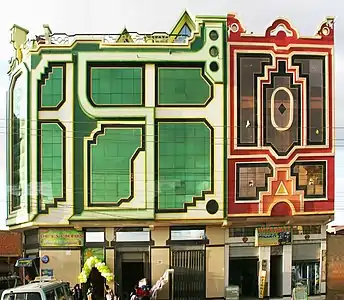
Museo de Arte Antonio Paredes Candia opened in 2002. From 2003, access from La Paz to the international airport, as well to oil and gas supplies, has been frequently blocked by protesting social leaders and some of the most powerful players in the politics of Bolivia. El Alto remains one of the major centers of the Bolivian gas conflict.
El Alto is known for its Neo-Andean architecture, built from the mid-2000s onward.[12][13][14]
There is a large open-air market.[14]
Gallery
 El Alto, Bolivia
El Alto, Bolivia University in El Alto (Universidad Franz Tamayo)
University in El Alto (Universidad Franz Tamayo) El Alto Airport
El Alto Airport El Alto, La Paz Department
El Alto, La Paz Department El Alto, Bolivia
El Alto, Bolivia.jpg.webp) Winter morning in El Alto
Winter morning in El Alto_on_the_right_-_LPB_airport_(in_El_Alto)_at_4160m_-_(24720405392).jpg.webp) El Alto, Bolivia
El Alto, Bolivia.jpg.webp) Cholet of El Alto.
Cholet of El Alto.
Government
El Alto is a municipality within the province of Murillo. The government of the city is divided into the executive and legislative branches. The mayor of El Alto is the head of the city government, elected for a term of five years by general election. The legislative branch consists of the municipal council, which elects a president, vice president, and secretary from a group of 11 members.
The current mayor is Monica Eva Copa, who defeated MÁS candidate Zacarias Maquera in March 2021 after being ousted by the El Alto party. The previous election was held in March 2021. The Government of El Alto faces competition in providing public services, security and participation with the grassroots and highly successful Fejuve movement.
Transportation
El Alto is connected to La Paz by three lines of the Mi Teleférico system. The city is connected to domestic and international destinations by El Alto International Airport.
References
- Neuman, William (2013-05-13). "A Colorful Bolivian Bastion, Floating Above It All". The New York Times. ISSN 0362-4331. Retrieved 2017-10-07.
- INE, Bolivia. "LA PAZ: POBLACIÓN TOTAL PROYECTADA, POR SEXO, SEGÚN PROVINCIA Y SECCIÓN DE PROVINCIA". INE Bolivia. Retrieved 26 May 2012.
- Bello, Kat (2022-09-15). "The Highest City In The World Has Hypercolorful Architecture". TheTravel. Retrieved 2023-10-07.
- Shahriari, Sara (12 Jan 2012). "Urban population boom threatens Lake Titicaca". The Guardian. Retrieved 26 May 2012.
- Shahriari, Sara (25 Jan 2012). "Dry Toilets: The Answer to a Bolivian City's Sewage Crisis?". The Pulitzer Center on Crisis Reporting. Retrieved 26 May 2012.
- Vidal, John (12 April 2011). "El Alto, city of rural migrants whose crops failed when the climate changed". The Guardian. Retrieved 26 May 2012.
- Rosenthal, Elisabeth (2009-12-13). "In Bolivia, Water and Ice Tell of Climate Change". The New York Times. ISSN 0362-4331. Retrieved 2019-09-28.
- Rocha, Jan (2016-11-28). "Shrinking glaciers cause state-of-emergency drought in Bolivia". The Guardian. ISSN 0261-3077. Retrieved 2019-09-28.
- "Klimatafel von La Paz – El Alto (Int. Flugh.) / Bolivien" (PDF). Baseline climate means (1961–1990) from stations all over the world (in German). Deutscher Wetterdienst. Retrieved January 24, 2016.
- "Base de datos Sistema Meteorológico–SISMET" (in Spanish). Servicio Nacional de Meteorología e Hidrología de Bolivia. Archived from the original on 21 September 2019. Retrieved 22 September 2019.
- "Station La Paz" (in French). Meteo Climat. Retrieved 11 June 2016.
- Allen, Eric (25 July 2018). "Architect Freddy Mamani Has Transformed El Alto, Bolivia, Into a Mecca of Modern Architecture". Architectural Digest.
- Blair, Laurence (21 May 2018). "These Vibrant, Futuristic Mansions Are Popping Up in Bolivia". National Geographic.
- William Neuman (May 13, 2013). "A Colorful Bolivian Bastion, Floating Above It All". The New York Times. Retrieved May 14, 2013.
Further reading
- Lazar, Sian (2008), El Alto, Rebel City, Duke University Press, ISBN 978-0-8223-4154-3
External links
- Weather in El Alto
- El Alto Bolivia at Discover the World
- El Alto Bolivia (in Spanish)—a blog
- Cultura en las Alturas (in Spanish)
- INE – Instituto Nacional de Estadística de Bolivia
- "My Travels With Pope Francis in Latin America" by Jim Yardley, The New York Times
